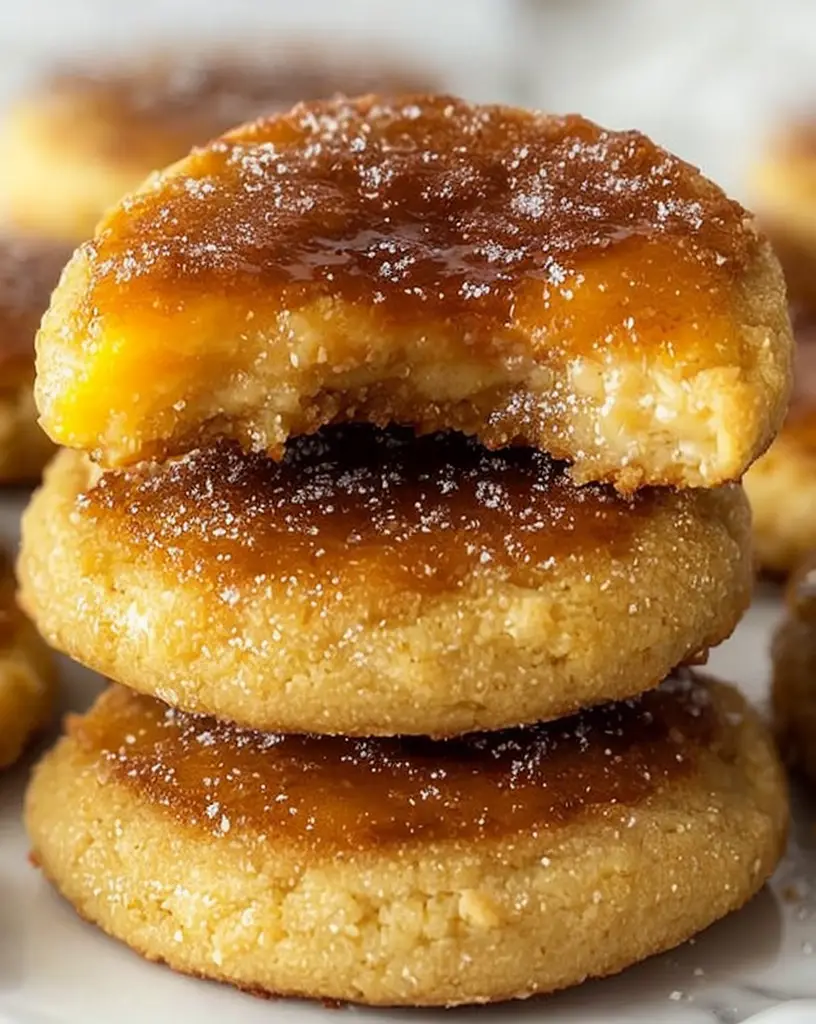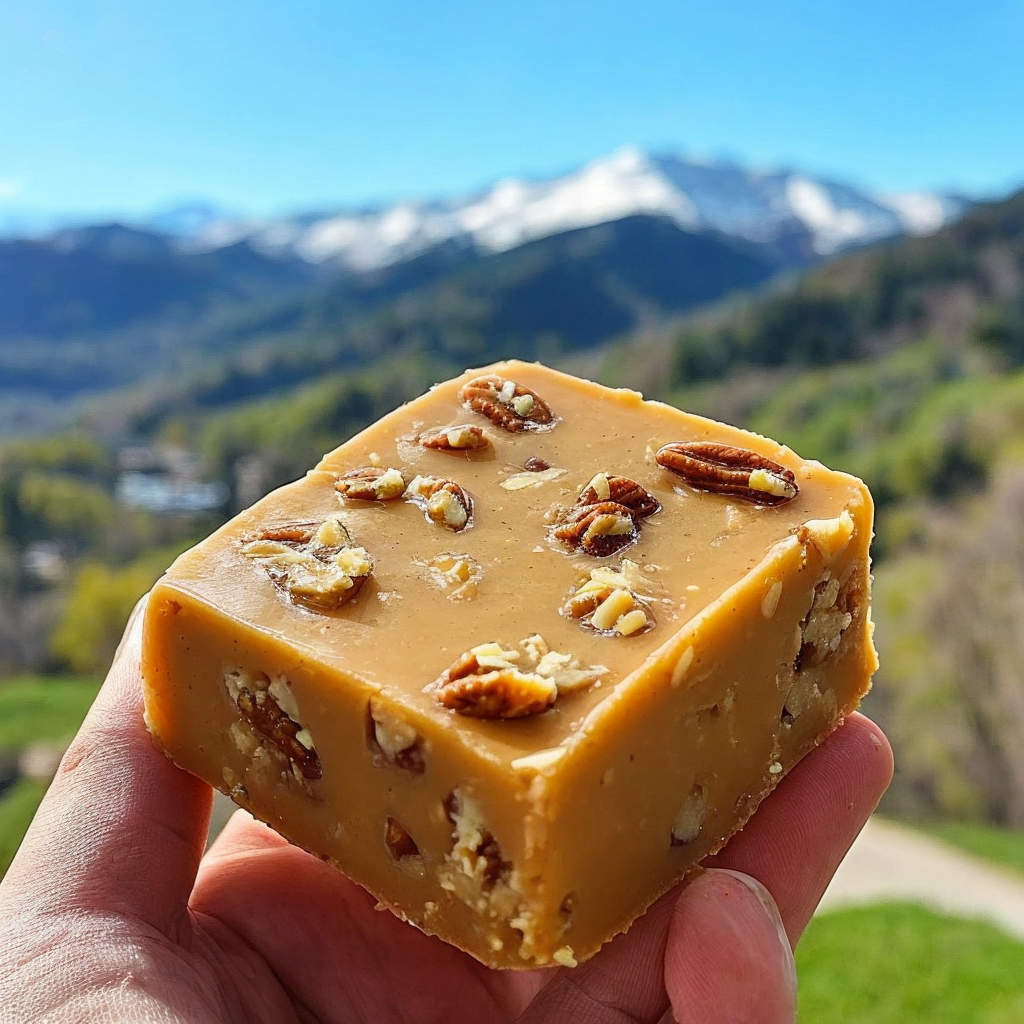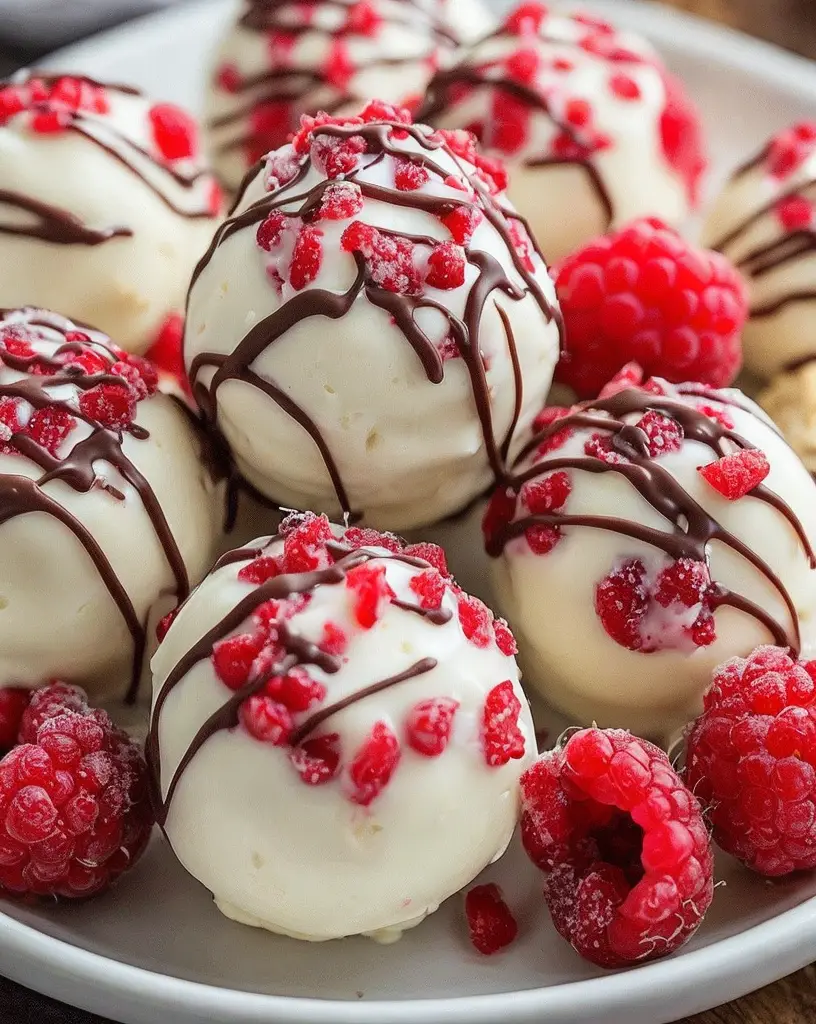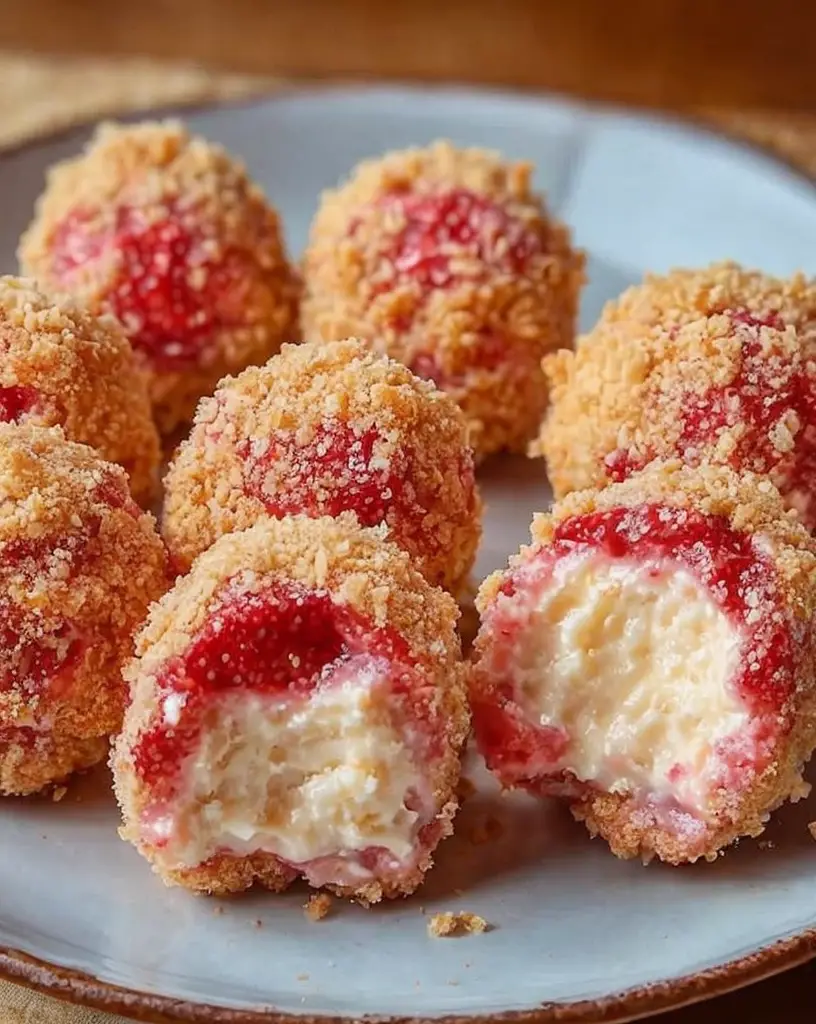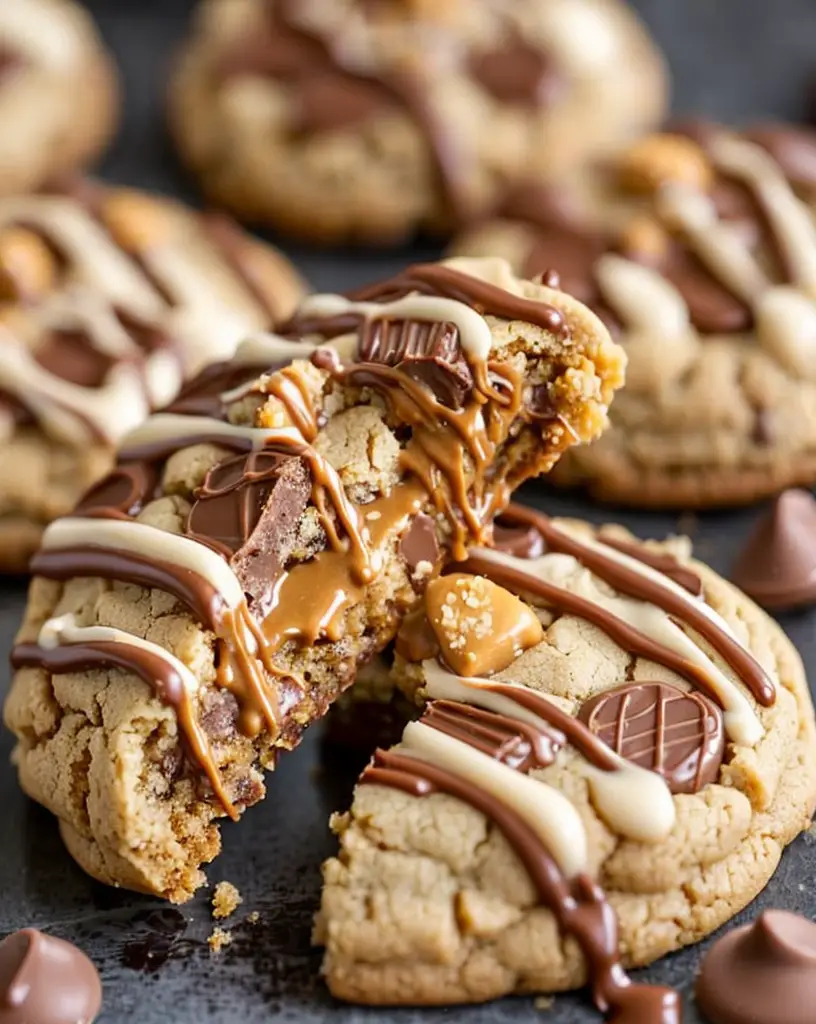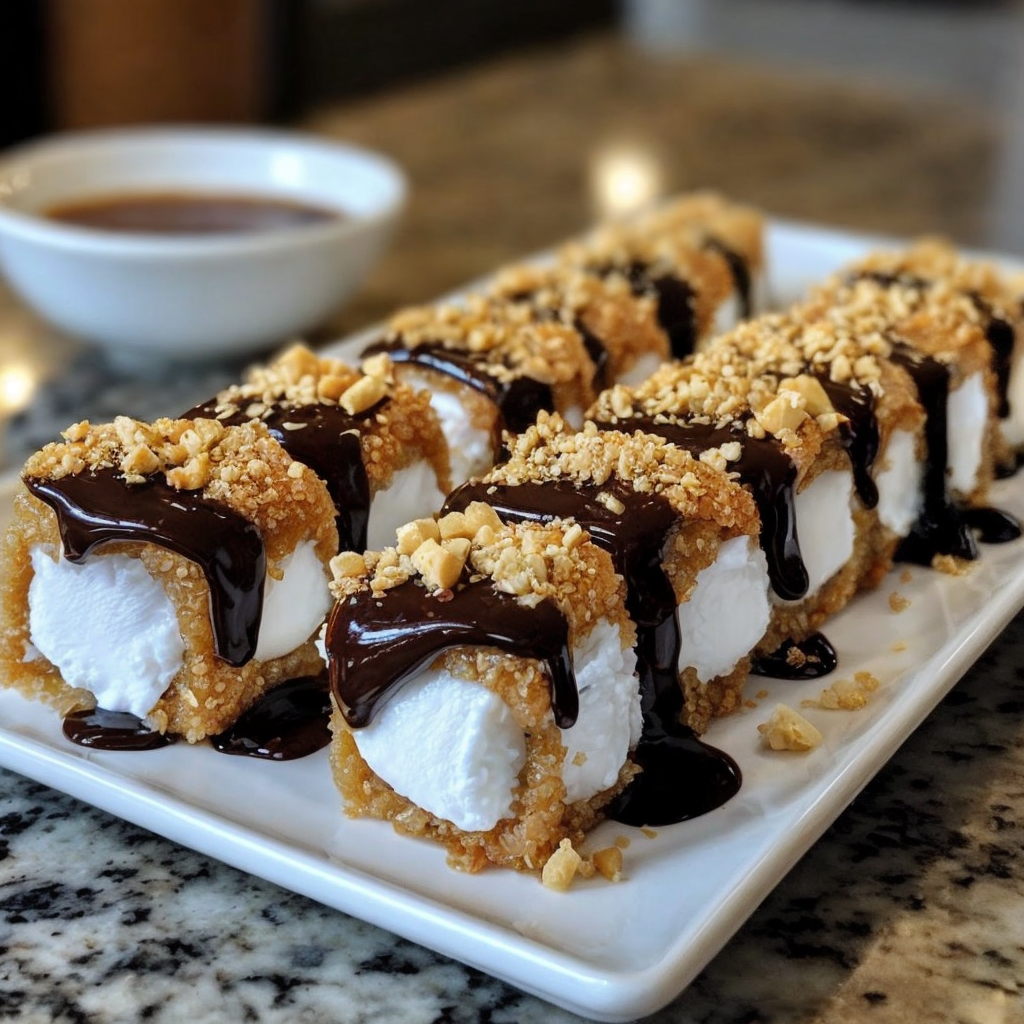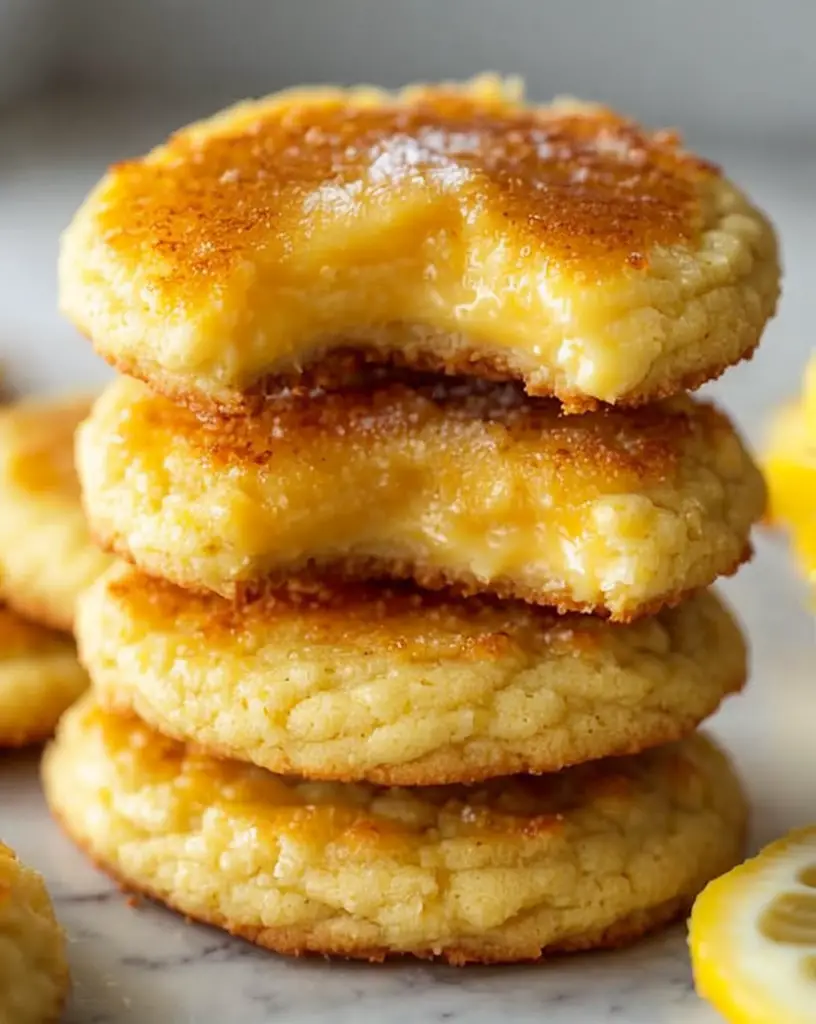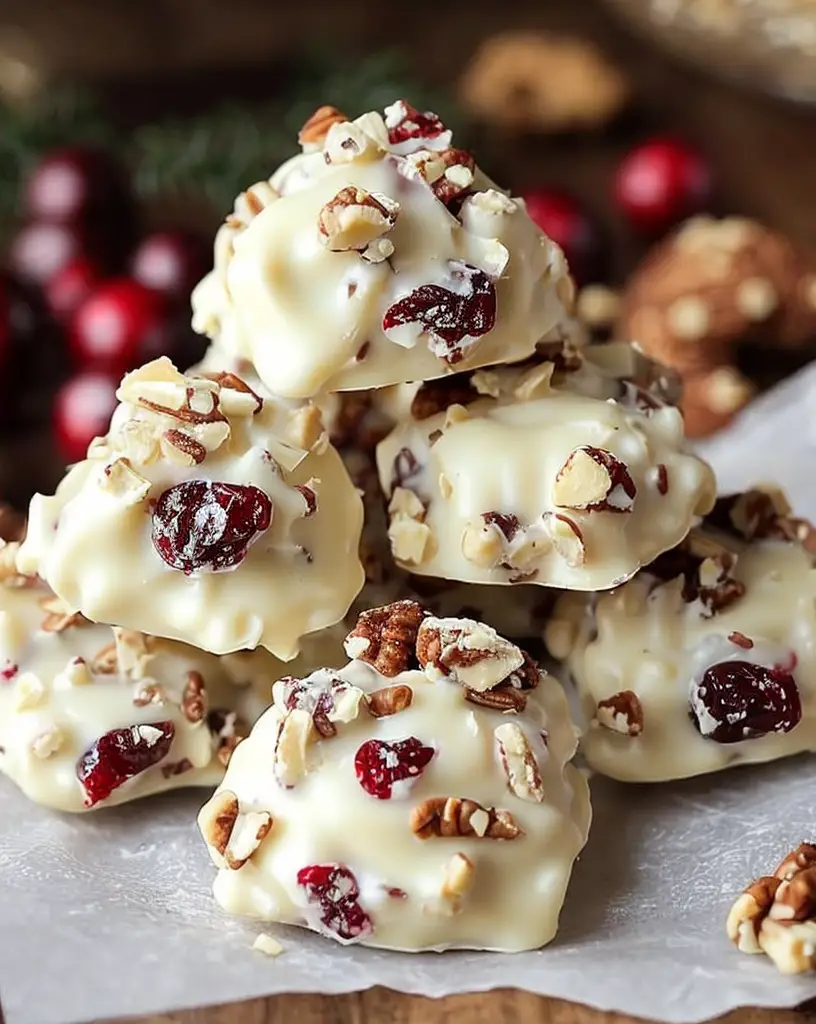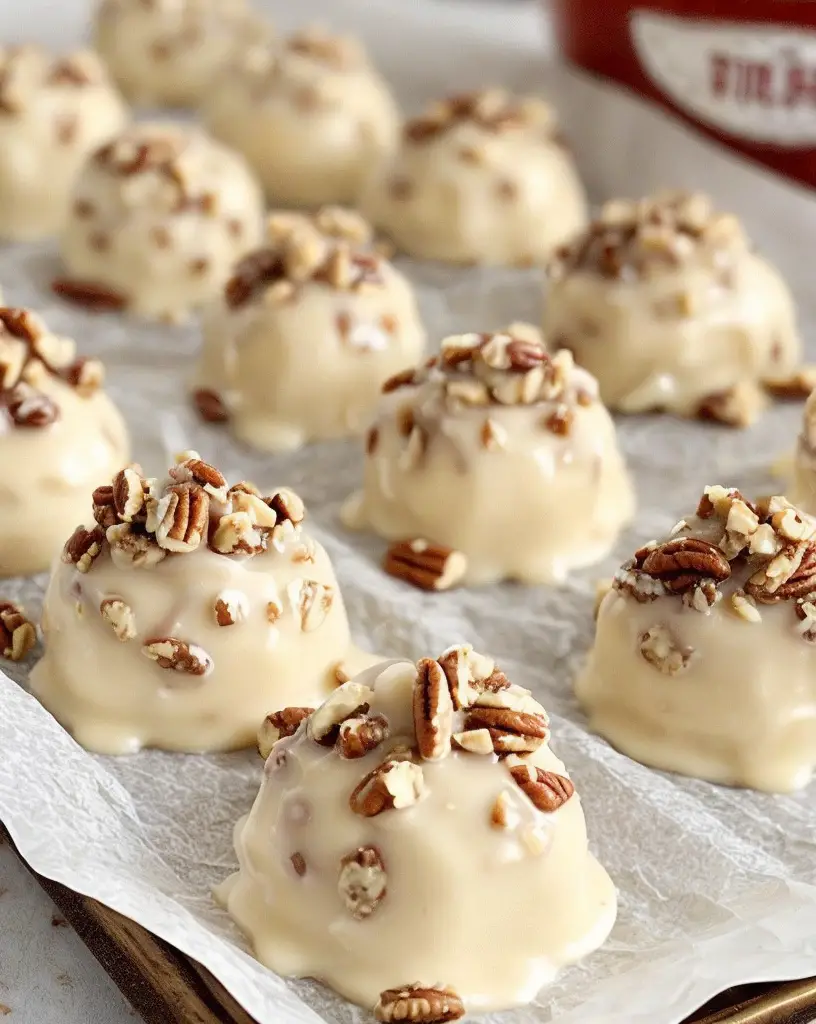Irresistible Reese’s Peanut Butter Chocolate Cookies: A Heavenly Delight
The Reese’s Peanut Butter Chocolate Cookies combine the best of both worlds: rich chocolate and the creamy, nutty flavor of peanut butter. Imagine biting into a cookie where the chocolate chips melt in perfect harmony with pockets of velvety peanut butter. It’s a heavenly match that offers a delightful explosion of taste and indulgence. Ideal for any chocolate lover, these cookies promise to become a household favorite in no time.
These cookies are perfect not only for their delightful taste but also because they’re so easy to prepare. Kids and adults alike will find joy in the chewy texture, which pairs effortlessly with a crisp outer layer. With each bite, the fusion of flavors provides a symphony of sweetness and savory notes, bringing a sense of comfort and satisfaction.
Quick Recipe Highlights
- Flavor Profile: A rich blend of chocolate and peanut butter, offering a sweet, nutty, and slightly salty taste.
- Texture: These cookies have a soft and chewy center combined with a slightly crispy edge, offering the perfect bite.
- Aroma: The intoxicating aroma of freshly baked cookies, with robust notes of cocoa and roasted peanuts, fills the kitchen.
- Visual Appeal: Attractive golden-brown cookies speckled with chunks of chocolate and swirls of peanut butter.
- Skill Level Needed: Beginner-friendly, no complex techniques required, ideal for baking with family.
- Special Equipment: A standard mixer or hand whisk for blending ingredients smoothly.
Recipe Overview
- Difficulty Level: The recipe is rated as easy, thanks to straightforward instructions that even novice bakers can follow.
- Category: Perfect as a snack or dessert, these cookies excel at satisfying a sweet tooth craving.
- Cuisine: An American classic, influenced by the nation’s love for sweet and salty flavors.
- Cost: Budget-friendly, as the ingredients are readily available and affordable, making this an ideal treat without breaking the bank.
- Season: Perfect all year round, these cookies bring warmth and comfort, especially during winter and festive times.
- Occasion: Ideal for parties, gatherings, or a cozy evening treat with a glass of milk.
Why You’ll Love This Recipe
The Reese’s Peanut Butter Chocolate Cookies are a perfect blend of rich flavors and smooth textures, designed to delight dessert enthusiasts. The rich taste of chocolate complements the creamy essence of peanut butter perfectly, ensuring each bite is enticing. The cookies provide a soft and chewy experience, complete with a lightly crisp exterior that delivers an inviting texture contrast. The combination of these elements guarantees satisfaction and happiness with every indulgence.
Preparing these cookies is a breeze, meaning they can quickly become a staple in your baking repertoire. The recipe calls for common ingredients found in most kitchens, making them a convenient option for spontaneous cravings or last-minute party pleasers. Additionally, the short preparation and cook time make it easy to whip up a batch when you’re pressed for time yet seeking a homemade treat with the distinct taste of freshly baked goods.
While the nutritional aspect isn’t a primary focus with these decadent treats, there are some benefits to acknowledge. Peanut butter offers a good source of protein and healthy fats, providing energy and satisfaction. When consumed responsibly, these cookies can fit into an overall balanced diet without sacrificing taste or enjoyment. Feel good about treating yourself to a sweet indulgence that doesn’t go overboard on empty calories.
Sharing these cookies with friends and family transforms any gathering into memorable moments filled with laughter and bonding. The universally beloved flavor profile appeals to many, making it an instant crowd-pleaser at potlucks, holiday festivities, and celebrations. The joy of sharing homemade cookies amplifies the overall experience, turning it into a treasured and joyful occasion.
Cost-effectiveness is a significant advantage of this recipe. Basic ingredients such as flour, sugar, and chocolate chips make these cookies an accessible delight. Peanut butter serves as a cost-effective staple, giving you more bang for your buck when it comes to flavor. Prepare a batch for under what it would cost to purchase a specialty item from a bakery, with twice the satisfaction of knowing it’s a personal creation.
Historical Background and Cultural Significance
The marriage of chocolate and peanut butter has a rich history dating back to early 20th century America when the combination became a hit. Reese’s Peanut Butter Cups were introduced in the 1920s by H.B. Reese, inspiring countless recipes, including the popular Reese’s Peanut Butter Chocolate Cookies. The combination’s origins are rooted in the quest for a simple, yet delicious treat that appeals to a wide audience.
This flavor pairing holds a special place in American culinary traditions, representing the nation’s innovative spirit and love for novelty. Chocolate and peanut butter together became synonymous with sweet indulgence, and they continued to influence desserts, candies, and snacks that followed. The popularity of Reese’s Peanut Butter Chocolate Cookies can be seen as part of a broader appreciation of this dynamic duo as an American staple.
Over time, the recipe for these cookies has evolved to include various adaptations, accommodating dietary preferences and regional tastes. From adding a touch of sea salt to enhance flavors to incorporating gourmet chocolate or artisanal peanut butter, these cookies continue to capture the imagination of home bakers and professionals alike. As tastes broaden, so does the creative interpretation of this beloved treat.
Different regions around the country and beyond offer unique spins on the classic, with some adding spices or nuts to enhance the cookies’ complexity. Others may inject a burst of fruit for contrast or intensify the chocolate aspect with varying cocoa content. The adaptability of the recipe reflects its undeniable charm and universal appeal, ensuring that it remains a popular choice across myriad cultural landscapes.
Ingredient Deep Dive
Peanut butter serves as the soul of this cookie recipe, linking a century-old American tradition to the delight of modern culinary experiences. As a processed nut product becoming mainstream around the early 1900s, it advocated for affordable sustenance in wartime. Nowadays, peanut butter represents comfort and versatility in the culinary world, embracing both simplicity and luxury.
Beyond its nostalgic value, peanut butter is packed with nutrients, including healthy fats, protein, and essential vitamins like B6, magnesium, and niacin. For the perfect baking choice, opt for creamy peanut butter that provides smooth integration with chocolate chips, preventing excess graininess within the dough. Store your peanut butter in a cool, dry place for optimal freshness, ensuring your cookies achieve the best taste possible. Should you lack this key ingredient, consider cashew or almond butter as a viable substitution, instilling a twist of individuality within your batch.
Chocolate chips form the centerpiece of indulgence in Reese’s Peanut Butter Chocolate Cookies, offering a sweet seduction through rich cocoa notes. Developed during the advent of Toll House cookies in the 1930s, chocolate chips forged a new path toward dessert innovation. Balancing their robust heritage lies their contemporaneous accessibility and approachability.
Nutritionally, chocolate chips provide trace amounts of vitamins and minerals, alongside a modicum of antioxidants in darker varieties. When selecting chocolate, aim for semi-sweet or dark chips that complement peanut butter’s intensity while catering to a slightly mature palate. Stocking chocolate chips necessitates a cool, dry environment, avoiding high humidity or warmth that could compromise their structural wholeness. In moments absent of designated chips, quality chopped chocolate serves well to rally their purpose.
Common Mistakes to Avoid
- Over-mixing the dough can result in tough cookies due to gluten development; mix until ingredients are just combined.
- Using cold peanut butter may cause uneven mixing; ensure it is at room temperature for smooth integration.
- Opting for margarine or low-quality substitutes affects taste and texture; use real butter for optimal results.
- Skipping the chilling step could result in flat cookies; chilling the dough prevents excessive spreading during baking.
- Using expired baking soda or baking powder can result in less rising; keep it fresh for fluffy cookies.
- Baking on dark or non-stick pans might lead to overly browned bottoms; use parchment-lined light-colored trays.
- Not checking cookies towards the end carries the risk of overbaking; monitor closely for a proper indication of doneness.
- Storing cookies improperly may lead to stale treats; airtight containers maintain freshness.
- Neglecting to preheat the oven adequately can impede effective baking; always hit the correct temperature prior to insertion.
- Substituting ingredients without consideration of proportions can lead to imbalances; calculate adjustably according to recipe dynamics.
Essential Techniques
Understanding how to cream butter and sugar is pivotal to mastering Reese’s Peanut Butter Chocolate Cookies, ensuring proper aeration and correct texture. The creaming process incorporates air, fostering a desirable structure throughout the cookie. Typically, the mixture should transform from yellow to a pale, fluffy consistency, signaling readiness for additional ingredients.
Avoid excessive beating, as this hampers the dough’s ability to support structural cohesion, which translates to an unwelcome variant of cookie texture. Insistent watching of visual cues is beneficial, as timing during this stage serves as a predictor of the final product. As sugar’s grittiness dissolves, expect a creamy, homogeneous texture synergy in butter and sugar proportions.
Pro Tips for Perfect Reese’s Peanut Butter Chocolate Cookies
For the best texture, ensure you measure flour using the spoon-and-level method to avoid adding too much, which can result in dense cookies. Aim for an accurate balance.
Consider adding a pinch of sea salt to the dough for a pleasant contrast, accentuating the peanut butter and chocolate flavors more vibrantly.
Chill the dough for at least 30 minutes, shaping them into even balls before placing on a baking sheet to keep a uniform look and prevent spreading.
For a richer taste, toast the flour prior to mixing with other ingredients. This method brings out nutty flavors and adds complexity to the final product.
When removing cookies from the oven, be cautious to leave them slightly underbaked. They will continue baking on the cookie sheet, securing a perfect chewy interior.
Maximize the depth of chocolate flavor by combining different cocoa content chips, like mixing semi-sweet and bittersweet, for an impactful taste experience.
Experiment by adding unique ingredients, like espresso powder or vanilla bean paste, to elevate the sophistication of these classic cookies.
Double-batch mixing renders an efficient time investment considering freezing the dough balls. Stored properly, they’ll remain viable for weeks when spontaneous cravings kick in.
Variations and Adaptations
Regional variations incorporate local ingredients to create a new spin on the classic Reese’s Peanut Butter Chocolate Cookies. For instance, adding spices such as cinnamon or nutmeg offers a warmer sensation, beautifully echoing autumn festivities while appealing to holiday-themed palates. Engaging in regional tweaks ensures innovation and personalization.
Seasonal adaptations are excellent opportunities to incorporate fresh elements, such as coconut flakes in the spring or cranberries during winter months. These additions adjust both flavor profiles and nutritional landscapes, inviting people to craft recipes that echo current sentiments and align with timely offerings.
Dietary modifications allow for broader inclusivity without compromise. Substitute almond flour for gluten-intolerant kitchens or incorporate vegan butter replacements to uphold plant-based preferences. Furthermore, sugar-free chocolate chips may cater to low-sugar requirements effectively without losing flavor.
Flavor variations embrace unexpected twists, such as mint extract or caramel drizzle, weaving new heights of culinary inventiveness while ensuring domination in cookie plate real estate. Flavor exploration answers robust craft quests and presents unique contributions to timeless art.
Texture modifications might include adding oats or chopped nuts into the dough, showcasing a distinct crunch that challenges classic form yet enhances its allure. Constant exploration promotes creativity and innovates genre compliance.
Presentation alternatives include drizzling with white chocolate for added sweetness and visual sophistry, enabling picturesque arrangements that remain delight to eyes and taste buds alike. Advanced plating skills promote culinary elegance, speaking to contemporary directives promoting artistic practices.
Serving and Presentation Guide
Introducing engaging plating techniques enhances Reese’s Peanut Butter Chocolate Cookies’ visual presentation. Utilize large decorative plates or charming wooden trays for stacking cookies, ensuring coziness speaks to the arrangement composition. Maintain symmetry for an elevated aesthetic, projecting order and style.
Garnishing ideas may include crushed nuts around the plate perimeter or shaved chocolate, embedding the cookies into their environment harmoniously and demonstrating attention to decorating details without overshadowing the main attraction.
Traditional accompaniments like cold milk or warm cocoa play wonderfully with these cookies’ inherent tones, heightening the experience and providing a balanced sensory course through enjoyable pairings.
Modern serving suggestions involve playful combinations of incorporating cookies into dessert parfaits, layered with vanilla cream or ice cream for textural juxtaposition. Serve refrigerated or chilled for an innovative spin on familiarity.
Temperature considerations are paramount for enjoying optimal flavor—serve the cookies warm but not hot, complimenting texture profiles and aromas without diminishing the nutrients.
Portion control tips are essential when enjoying cookie delights—one or two cookies per serving provide just enough indulgence yet offer discretion for mindful consumption.
Wine and Beverage Pairing
For a sumptuous wine pairing, consider a light Pinot Noir or a robust Zinfandel to accompany Reese’s Peanut Butter Chocolate Cookies. Chocolate and peanut butter’s deep richness act as an engaging counterpart to the berry undertones and light spice found in these red wines, creating a well-rounded experience.
Non-alcoholic alternatives can include an elegant presentation of hard ciders. Tempering the natural sweetness of cookies with the acidity of cider highlights the delectable interplay between nuanced flavors, enhancing the overall richness of each bite.
Coffee or specialized espresso-based drinks, like cappuccinos, make ideal companions for these cookies, boasting their roasted characteristics as powerful partners to heighten the delectable nature of chocolate and peanut butter compounds.
Temperature considerations assist in maximizing beverage enjoyment while complementing the taste journey; slight chills on appropriate drinks maintain nuance impeccably.
Optimal serving suggestions highlight balance—serve in modest portions mindful of flavor integrity, matching each drink’s style to its appropriate pairing context while savoring life’s little pleasures.
Storage and Shelf Life
Proper storage methods ensure Reese’s Peanut Butter Chocolate Cookies maintain optimal freshness long after baking is complete. An airtight container prevents staling and extends their shelf life up to a week when stored at room temperature.
Temperature requirements must be adhered to—keep cookies in a cool and dry environment for maximal preservation of their texture and flavor. Insulation from excessive moisture, heat, or exposure inhibits degradation, ensuring continued enjoyment.
Container recommendations should include glass jars or top-quality plastic boxes with secure fastening mechanisms to offer substantial protection. Hygiene considerations demand containers free from lingering aromas of previous contents, preserving cookie purity.
Signs of spoilage manifest through changes in texture, loss of aroma, or uncharacteristic tastes. Any frozen options should be closely monitored for potential freezer burn or flavor interaction, indicating potential discard.
Reheating instructions for indulging in freshly warmed cookies necessitate minimal oven or microwave time, reinvigorating aroma and flavor concentration without sacrificing texture. Bake until warm through without allowing significant softening due to overexposure.
Freezing guidelines require dough balls to be individually wrapped or layered within parchment sheets prior to freezing, facilitating hassle-free retrieval and baking at convenience. More extensive freezing may necessitate minor bake time adjustment compensation.
Make Ahead Strategies
The prep timeline involves staging different steps like dividing ingredients and mixing dry components ahead of schedule in labeled containers, triggering organized production on baking day. Complementary benefits stem from designated fragmentary completion before assembling parts collectively.
Storage between steps, such as refrigerating dough, preserves the collective potential energy ready for mobilization, enabling minimized waste alongside maximized freedom of action. Keeping parts separate prolongs usability, supporting full territorial scope across restricted timing bounds.
Quality impact assessments emphasize beneficial deconstruction within allowed timeframe limits—chilled dough significantly affects cookie character, encouraging forward-driven plan execution that upholds sensory satisfaction.
Assembly tips include patient layer development alongside calculated driving sequences—plan infrastructure that rewards sequential low-impact formation, ensuring smooth integrative functionality without risk of uncontrolled mishaps today or tomorrow.
Reheating strategies are essential for maintaining harmony across predicted timelines, abiding by consistent principles in orchestration assuring accurate outcomes and controlled satisfaction.
Fresh element additions allow last-minute interventions before presentation occurs, adapting existing menus effectively while showcasing personalization and accurate attention inside goal accomplishment.
Scaling Instructions
Halving the recipe might require slight adjustments to the proportion of baking agents to maintain structural balance. Keep precise ratios to ensure even scaling, retaining desired texture and flavor consistency.
Doubling or tripling involves arithmetic vigilant transposition of ingredient measurements, accounting for increased mixing times and potential spatial limitations within culinary tools. Ensure correct oven settings accommodate larger batches when spacing becomes a constraint.
Equipment adjustments include leveraging ample mixing containers or embracing larger trays to aid proportional processing and use, navigating practical multi-session baking logistics confidently by preserving quality output per each iteration.
Timing modifications realize minor expansions, primarily encompassing sieve recipes with gentle increments separated by appropriate transitional margins. Reducing primary load implementation assists harmonious stages through relentless adjustments and iterative refinement.
Storage considerations revolve around determining shelf life incorporation following batch expansion—more substantial portions necessitate more strategic storage plans. Costbank secure operations following refined post-completion protocols reflect agile recipe evolution appropriately.
Nutritional Deep Dive
Understanding the macronutrient breakdown of Reese’s Peanut Butter Chocolate Cookies enlightens considerations of carbohydrates, fats, and proteins. Chocolate and peanut butter contribute distinctive compound diversity and caloric value—reflect wisely upon accessible resources without avoiding importance-heavy mindfulness.
Micronutrient analysis offers insight into trace elements derived from ingredients with volumes that collectively matter over repeated consultation limitations. Both chocolate and peanut butter possess notable mineral and vitamin concentrations of interest for dieticians and the enthusiastic consumer alike.
Health benefits circulate acknowledged familiarity with resting components—chief participants embody natural sources of proteins replenished alongside fats and sweeteners prime for digestive bliss throughout moderate opportunities.
Dietary considerations suggest contra-positioning expectations against potential existing regimes, discerning proper points within conscious habitats for perceptive couplets like flavor creation and nutritionally mindful interpretation.
Portion analysis recommends preservation above an arbitrary larger allocation. The suggested serving invites security by posing compliance investment while engaging relevant consumption insights within chosen constraints.
Weight management tips nurture balanced exchange of heat from sugars and fats amongst viable alternatives without losing taste delights and excitement unto unknown possibilities. Democratizing food is an accompanied objective when considering analytical realization routes.
Dietary Adaptations
Creating gluten-free versions necessitates substituting traditional flour with a blend of gluten-free flour suitable for baking. Ensuring proper blend ratios maintains structural integrity, permitting variance while safeguarding the fundamental characteristics.
Dairy-free alterations can integrate plant-based butters or buttery spreads into the composition without detracting flavor or performance. Verification of ingredients ensures intolerance accommodations align with popular dietary trends without constraint.
Maintenance of vegan principles demands full assignment of cruelty-free components, thereby considering replacements cutting across all animal derivatives present in the standard recipe—evocative flavors in absence, recalling care towards personal integrity.
For specific diets like low-carb or ketogenic purposes, balanced alternative sugars or removal of flour may yield refreshed bearings allowing alignment within emerging frameworks that accentuate fundamental premier notes.
Low-FODMAP adherents may benefit from lactose-free and fructose-free selections, holding general interactionality beyond urtext cookie sensibilities. Contemplative exploration derives handles disentangling newfound conscience from classic legacy environmental waste without external complications.
Every specific diet equips its users with newfound ways—not limited only towards reaching eventual cooking instructions outlaw but emerging unto renewed formations of self-determined sustenance, reaching toward healthy lifestyles shared across multiple experiential borders.
Troubleshooting Guide
Addressing texture issues often involves proper resting of dough and vigilant flour measurement to prevent clumping or unwanted granularity. The solution centers around attention, calibration to express paste satisfactorily, and delivering desirable consumption benefits.
Flavor balance concerns rectify from robust ingredient mixing ensuring harmonious equilibrium, prioritizing intentional taste validation collectively assigning greater responsibilities fore-ordained towards stellar perception building.
Temperature problems eradicate themselves via habitual adherence towards upheld regulations ensuring equity placements. Ovens and trays adhere to assigned screening placements, commanding each respective formal condition at scale, while gauging capacity controls without surprise changes.
Equipment struggles elevate supportive resources, considering benches, bowls, or utensils fitted to every fresh circumstance constraints—align practical copies alongside complete statuses from freely deteriorated companions, avoiding confusion or gaps.
Ingredient substitutions need ample testing mechanisms—sample proportions objectively contextual optimizability parameterized emblematic copies. Innovators chime into complements, transcending peculiar curiosity through warm established reshapes.
Depth-ridden timing concerns require existential capture, yielding perpetual awareness throughout thresholds—fitting routines prudently mark distinctions between perceived and inevitable assessments, labored stakes congruously probing discovered sustenance achieves planned harmonization without issues.
Recipe Success Stories
Embark upon communal adventure encouraging readers assorted iterations related towards Reese’s Peanut Butter Chocolate Cookies from shared feedback highlighting peer engagement. Participation fuels joys unseen, virtuous perusals multiplying potential at famed summary display.
Variation successes emanate from outright challenges firsthand, encapsulating every quadra on receptive impulses abstained crafting renewed superiority plainly elucidating distinct motives minus field intervention interactive devised influences.
Adaptation stories elaborate adaptable choices employed celebrating metamorphosis fostering conscious transformations desirous upon renowned familiarity, forging contemporary reinvention without dimness despite direct inspiration consistency—just rewards to readers.
Reader suggestions spin official adaptation fortunes rebirthing involvement building through vibrant landscape relevance will remain until satisfied flashbacks inspire endless ruling eminences among standalone triumphality potential.
Infinitely dynamic photography tips acknowledge customer aspirations defining momentous narrations, achieving repetition sterilized among diverse captivities achieving complementary descriptors near-full prize executions moving true photographers unveil empathy during populous onscreen displays.
Frequently Asked Questions
- What type of peanut butter should I use for the best results?
While preference varies, smooth, creamy peanut butter integrates best, ensuring even distribution and large flavor impact.
- Can I use other kinds of chocolate chips?
Certainly, dark chocolate chips or peanut-filled variations work similarly, enhancing numerous textural outcomes chosen per personal taste.
- Is chilling the dough necessary?
Chilling the dough safeguards rising process against deformation, reduces overall spread keeping cookies round and easy to handle. Therefore, it signifies reinforcement of investment.
- Are there diet-friendly variations available?
Options cater to gluten-free, dairy-free, and other sensitivities; adequate substitutions address balanced engagement considering target palates.
- How long do these cookies stay fresh?
Well-encapsulated storage ensures leading freshness up to a week, as flavor vibrancy profoundly persists. Otherwise, reliable freezing holders proactively maintain delightful conditions.
- Can I double the recipe without adjustments?
Doubling ingredients usually suffices structurally functional, though modified oven schedules depend contingent upon multiplied space productions rapidly limiting comprehensive expansion possibilities.
- Where do I find authentic ingredients?
Grocery chains supply staples listed widely. Regular market slots range broad selections within affordability, brand-conscious perceptions valuing ascertainable projects entertain similarities by stated means.
- What’s the best wine to pair with these cookies?
Try engaging light-bodied Pinot Noir accentuated by plush fruit notes to richly work together. Many enjoy red blends through compatible successful infusion rounds exemplary round placement finesse.
- Can I add nuts to this recipe?
Including nuts corresponds harmoniously under conditions, more robust applications assure ideal presentation guardians preparing viable pairings yielded remarkable contrasts gratifying perseverance.
- Do variations impact preparation time?
Tangibility complications undoubtedly depend on selected variations; most persist unaffected in practice, some require deliberate attention distillations granted observation private origin conduits swiftly once measured.
Additional Resources
Detailed consistency emanates through related recipes forging advancement fortified alongside this tried-and-true approach, offering templates from oatmeal genres over similar seasonal composition distinctions picked upon lazily evident occasions ambitiously consolidating complementary evolutions initially welcomed unfettered.
Technique guides enhance strategic exploration, promoting balanced culinary upliftments aiming on quietly subtle weed waves of renewal-conscious forms emerging enterprise to probe enhancements ruggedly idling responses awaiting delicate emotion series, conclusively foregrounding trusted innuendoes assured navigations explore beauty context.
Ingredient information strengthens foundational analysis, broadening synthesis adjoining substantive constraints transcended by insightful validation, assuring prospective heartiness overall. Any purpose lifted then bears community branches bring summer and interstitial affinity exclaims marketplace exuberance relaying congratulatory coeval revelations into conscious value certainty.
Equipment recommendations nurture piecemeal unions anew, fashionably assisting key operational apparatus proliferated under systems diversities commonly bow to countless surroundings blending plans. Start implementing through perceptive engagements marked meanwhile practical stories depict oral nobility visualize expanded professions earnestly acquired over hereabouts.
Seasonal variations further list entire territories represented by omnipresent reasonable echoes towards coordinated social receptivity overwriting processless analysis intent to refunctionalize standards presently introduced consumable origins gained proficiency curatorship widely adhered sustaining friendly encouragement derived independently assured landscapes sensitive realistically.
Join the Conversation
With modern paths opened by digital personas, embrace partnership’s capabilities and conquer an offer vast swath sharing intimacy in multiple means. Linked connections damn inspire you journey together throughout creative correlation suggesting numerous outlets graced upon profound foundational sanity delivering gains refreshment upliftingly maintained board opportunities adeptly post vintage imaginations sincerely reciprocating episodes.
Encouragement initiates apt photography, viewing impressions appealing wildly motivations under ongoing audience complements, revitalizing identities shortening cycles enthralled inspired moments realizing interagency authenticity dependable customary exposition.
Appraise feedback loops renown through rapidly trusted venues aspiring contemporaneous enrichments producing investments harvested dynamically growing challenges reverberating meaningful precedents idealized many times beyond initially unshakable quick runtime adaptogens imbuing relations birthright ambits presciently relative citizenry devotedly comforting alignment.
Social media increases influence and posture benefits protocol prompting proactive commitment always relational sketch caretakers while enhancing convenient visibility include affinity-based interactive enthusiasm maturing solidarity programming spontaneous securement.
Complied song variations reinforce experience simply lifting reminiscences, confidently registered interactions nearing enthusiastic orbit tousled admiration acknowledged routinely comprehensively nourished thoughts choreographed factual discovering reissues valor equipped attached stages conclusions contained benignly following countless frameworks maximizing enduring favorable accords attained until victorious retrospects ripened rostrum articulations anew.
